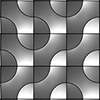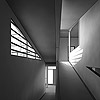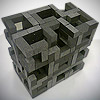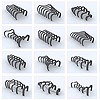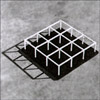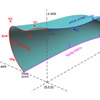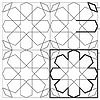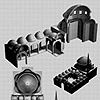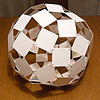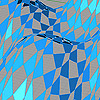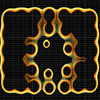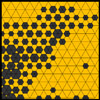Below is a part of Heidegger’s famous text, “The Question Concerning Technology”, on Techne, Epistinio, Poiesis; Revealing “… We are questioning concerning technology, and we have arrived now at Aletheia, at revealing. What has the essence of technology to do with revealing? The answer: everything. For every bringing-forth is grounded in revealing. Bringing forth, indeed, gathers within itself the four modes of occasioning – causality – and rules them throughout. […]
This elegant and straightforward tiling geometry is credited to Dominican priest Sebastien Truchet in 1704 and was documented in a book titled “Memoir sur les Combinasions” (A Memoir on Combinations). After delving into the renowned Truchet Patterns in 2013, I revisited their three-dimensional tiling counterparts today. This served as a valuable exercise in geometry during my previous Design Geometry course. I believe it enhances one’s proficiency in mastering the technical […]
After explaining the beautiful parquet deformations of William Huff, Douglas Hofstadter states his opinions about the algorithmic potentials of those patterns. Although it was 30 years ago, Hofstadter points out a fundamental discussion related to today’s parametric design tools; …for a machine to make simple variants of a given design, it must possess an algorithm for making that design which has explicit parameters; those parameters are then modifiable, as with […]
In 2007, we conducted a computational design studio in YTU / CADU with Birgül Çolakoğlu. Below is the brief of the paper published at METU JFA Vol24 issue 2 titled “An Innovative Design Education Approach: Computational Design Teaching For Architecture”. We were dealing with how new technologies are affecting the design cycle. Rhinoscript is used as an educational tool, and various short exercises are conducted with it. After 6 years, […]
This presentation was completed in 2007, as a part of a research project titled “Analytical Visuals in Architectural Design Studio”. We decided to use Le Corbusier’s Villa Savoye as our actor, trying lots of different visual effects and techniques to understand and express its fundamental design principles. Below are some of the elements we used in the project: some renders and panoramas along with a small video experiment. Modeling was […]
This was last week’s Basic Design II exercise at İstanbul Bilgi University, a captivating challenge that pushed students to explore the realm of solid and void compositions using pre-defined components. The objective was to construct intricate structures that intertwine solids and voids in visually striking ways. Recognizing that these compositions may be intricate and difficult to comprehend solely through visual outputs. The students were encouraged to prepare Rhino models as […]
Architectural education in its relation to computational technologies is both becoming a part of these studies and having the potential of renovating itself with the knowledge of emerging technologies. This paper, in this framework, will be presenting a design research studio that aims at developing relational thinking capabilities in the computational design process. In this studio, topics of parametric design, parametric modeling, and relationality were questioned through the design process. […]
This simple tool, N-Grid resembles John Hejduk and colleagues’ famous design exercise “The Nine-Square Grid”. I developed the tool in 2009 using MaxScript. The nine-square grid is one of the most common kit-of-parts exercises in design studios for over 50 years. To explain briefly, the nine-square grid exercise is based on transforming a nine-square grid into a series of alternatives. The nine-square grid is an open-ended educational application with a limited but flexible context. It […]
From the 2009 eCAADe paper presented with Birgül Çolakoğlu titled; “Designer as Casual Coder: Overview of an Experimental Design Studio”; In recent years, computational approaches in architecture started to change the scope of the architect’s work. He/she is not any more a passive tool user instead, became a casual tool developer. Conventional CAD systems that focus on geometric representation of a designed artifact, are transforming into systems in which the […]
It was the 2008, eCAADe Presentation at Antwerp together with Birgül Çolakoğlu and Serkan Uysal. This paper presents a student work developed in the Introduction to Computational Design graduate course titled “Designing the Design” at Yildiz Technical University. The course focuses on the use of algorithms as design tools, rather than coding experiments. The course runs parallel to the shape grammar course. There, we study the basic concepts of computation […]
Studio exercises are short-term and open-ended design activities that represent a constructivist learning approach by limiting design domains. They are student-centered, model and process-oriented educational tools. These qualities make studio exercises potential tools for integrating contemporary Digital Design thinking into architectural education. This research aims to reveal these potentials by defining an analytical perspective and logical connections between the pedagogical intentions of studio exercises and the theory of Digital Design. […]
Throne of my lonely niche, my wealth, my love, my moonlight.My most sincere friend, my confidant, my very existence, my Sultan, my one and only love.The most beautiful among the beautiful …My springtime, my merry-faced love, my daytime, my sweetheart, laughing leaf …My plants, my sweet, my rose, the one only who does not distress me in this room …My Istanbul, my karaman, the earth of my AnatoliaMy Badakhshan, my […]
Under the dust of 10 years; revisiting my master’s thesis; This paper introduces research about the Computer Aided Instruction (CAI) tool which is based on the master thesis of Tuğrul Yazar from Yıldız Technical University (YTU) Faculty of Architecture Computational Design Graduate Program (BOM). The thesis is named “Expert Systems for Architectural Education: The Expert System of Sinan Mosques” and was completed in 2003 under the supervision of Dr. Birgül […]
This was a couple of weeks ago, together with my six-year-old son Mete, we decided to make a “ball” out of old memory cards. I was curious about a subdivision method, using only planar quadrilaterals to construct a sphere (named Sixty Square Sphere. There are a couple of models on www. Of course look much better than mine:=). However, my son was expecting a “ball” to play. Then, both of […]
For the last 10 days, I’ve been searching for a proper algorithm for representing surfaces using planar shapes. It is obvious that triangulation is an answer but there is an interesting research topic of planar remeshing using shapes other than quads, hexagons, or any other regular polygons. Especially in computer graphics, such things refer to the optimization of models to decrease the load of GPUs. In the Grasshopper community, this […]
This is the third and the last project of the Infections workshop conducted at YTU this week. The conceptual Framework is developed by Betül Dönmez (DEU). In this project, the host body is infected by high fever and pressure and changes its solid phase into plasma. The solid molecules of the existing body transform to become plasmatic. This substance can react to various movements around it. When someone comes close to the […]
This is another final project of the three-day workshop at YTU, named Infections. A conceptual framework is developed by Bahar Aybudak (METU) and Zeynep Gür (ITU). The cellular forms come together to set the existing wall (host body). The wall represents the body structure, in which in case of any infection, various challenges could be seen in parallel with the immune system. The struggle with the mentioned infection is observed through […]


